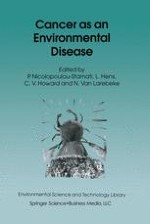2004 | OriginalPaper | Buchkapitel
Gene-Environment Interaction in Environmental Carcinogens
verfasst von : H. Autrup
Erschienen in: Cancer as an Environmental Disease
Verlag: Springer Netherlands
Enthalten in: Professional Book Archive
Aktivieren Sie unsere intelligente Suche, um passende Fachinhalte oder Patente zu finden.
Wählen Sie Textabschnitte aus um mit Künstlicher Intelligenz passenden Patente zu finden. powered by
Markieren Sie Textabschnitte, um KI-gestützt weitere passende Inhalte zu finden. powered by
Large inter-individual variation has been observed in the metabolism of chemical carcinogens, and the genetic basis for some of this variation has been identified. Gene-environment interaction is important in the development of cancer, e.g. genetic polymorphism in enzymes involved in activation and deactivation of environmental carcinogens influences the level of the ultimate carcinogenic compound leading to chromosomal damage, and, subsequently, an altered risk of developing cancer. The effect of the genetic polymorphism depends both on the chemical identity and the level of exposure. In case of exposure to polycyclic aromatic hydrocarbons, smokers with either the CYP1A1*2 or the GSTM1*2/*2 genotypes have an increased cancer risk. However, the risk associated with a genetic polymorphism in a single gene is not very high, as the enzyme only represents one of the many pathways of metabolism. Combining information on genetic polymorphism in many genes involved in competing pathways of biotransformation, i.e., gene-gene interactions, significantly improves the risk-estimate, e.g. smokers possessing both GSTM1*2/*2 and CYP 1A*2 had a significantly higher risk of developing cancer than smokers with only one of the genotypes. Genetic polymorphism in other enzymes involved in xenobiotic metabolism is also associated with an increased risk of different types of cancer, but in each case it is important to focus on both the type and level of exposure, as the genes by themselves do not have any significant effect on the risk of cancer development.
